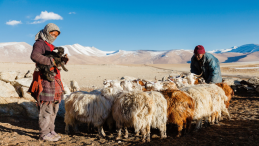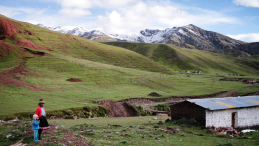Mountains are highly exposed to the impacts of global warming, especially through the melting of glaciers, which are critical for water provision. Known as the "water towers" of the world, mountains provide vital water and ecosystem services, making them central to climate change impacts. While it may seem that mountain-specific issues remain isolated and ‘stay in the mountains’, this is far from true. Failing to address climate risks in mountainous regions makes it harder to mitigate their consequences in lower, more populated areas. We sat down with Paola Fontanella Pisa, one of our Global Mountain Safeguard Research (GLOMOS) experts in disaster risk reduction and resilience building in mountain regions, to tell us more.
How can disaster risk reduction strategies be tailored to address the unique cultural, historical and socioeconomic context of mountain regions?
Decisions for mountain areas are often made by outsiders with little connection to the region. This detachment makes effective policymaking harder. Additionally, the definition of a "mountain" is context-specific, shaped by local culture and perceptions, meaning disaster risk strategies must be tailored to each area's unique challenges.
All over the world mountain communities often face common issues like marginalization and limited access to services, that in addition to the steepness of the terrain contributes to residents being more exposed and more vulnerable to hazardous processes such as flooding events, avalanches and rockfalls. Local conditions can make these challenges even more difficult, as we noticed ourselves in a remote valley in the Julian Alps where we were doing fieldwork recently. Poor infrastructure, isolation and intensified rainfall due to climate change created dangerous living conditions for the people in the valley.
To improve disaster risk reduction, both top-down and bottom-up approaches are necessary. While broader frameworks help, local input is critical to ensure policies meet community needs. Incentives must be created to keep communities intact, providing essential services like schools and healthcare while ensuring safety in an increasingly unpredictable environment. Without addressing these concerns, people will continue to leave mountain areas, which weakens the social and economic situation necessary for resilience.
How can the integration of local knowledge and Indigenous practices enhance disaster risk reduction and resilience in mountain communities?
Global frameworks, like the Sendai Framework, and national policies are important for setting the frame and guiding broader initiatives. However, local knowledge needs to be integrated in plans that apply these frameworks by means of concrete actions in risk management at the local level. Solutions are context-dependent and require aligning broader measures with the community's historical experiences and traditional practices.
By combining Indigenous knowledge, societal networks and past disaster experiences with strategies developed by governments or international bodies, disaster risk reduction efforts can be more relevant and effective, ensuring that communities are both engaged and resilient in the face of hazards.
Can you give an example of where local knowledge has effectively contributed to risk mitigation?
From my fieldwork in Japan, I have a concrete example from Tadami, a remote mountain area in Fukushima prefecture with significant outmigration. The remaining residents face hazards like flooding and landslides, but their community has long relied on mutual support. In Tadami, the settlements, or shuuraku, are further organized in sub-groups of eight houses of which the residents regularly meet and share information. They know who has food, blankets or where to find water in the mountains, and they help vulnerable members such as elders during emergencies.
In July 2011, heavy flooding cut off one of the municipality’s valleys from the outside world and damaged some of the houses of the valley’s inhabitants. Civil protection units arrived by helicopter to evacuate the residents. However, the people declined evacuation, confident in their preparedness with food, water and shelter. They preferred to stay and rebuild immediately, rather than leave the valley for temporary accommodation elsewhere. This example gives us an understanding that communities could have more resources than we might think. Still, it is important not to leave communities on their own in case an event exceeds their coping capacities, which is why aligning informally developed measures with local plans as well as with wider developed emergency strategies could be beneficial.
Moreover, not everyone in mountain communities perceives hazards and related risks the same way. Those engaging with the mountains through activities like forestry or hunting are likely to have a different understanding of risks than those working in villages or in the fields. For example, farmers often tend to focus on threats to crops, while others might fear different dangers. Recognizing the diverse perspectives and needs within these communities is crucial for developing disaster risk reduction strategies that truly address their specific vulnerabilities and experiences.




